Tested: The Power to Stop

From the August 2008 issue of Car and Driver.
All of us who have explored the envelope of a high-performance car know how much confidence comes from a great braking system. But what exactly makes a brake system great?
Brake feel is important to a demanding driver. A car that slows in a fashion that is closely related to how hard and how far the driver is pressing the brake pedal allows the driver to control braking with great precision. Although braking systems have become more linear and predictable over the years, there are still noticeable differences among cars in brake feel.
Another key factor is a short stopping distance—the length of road needed to slow down the car. That’s why we measure 70-mph-to-zero performance on all vehicles we test. But every car has brakes strong enough for the anti-lock system to hold its tires on the verge of lockup for at least one stop. So when a vehicle’s brakes are cold, the stopping distance is more dependent on the traction of the tires than the power of the brakes.
The ’hockey puck’ is the Futek pedal-force sensor, and the yellow brake trigger recorded exactly when we hit the pedal.
MORGAN SEGALCar and Driver
That leaves fade resistance as the biggest differentiator among modern braking systems, and so it’s the focus of this test. And although just about every vehicle has one good stop in it, only the best vehicles can maintain their braking performance during hot laps on a racetrack or down your favorite mountain road. A pedal that goes mushy after the fifth hairpin bend will terrify even the most experienced driver.
MORGAN SEGALCar and Driver
Brake fade happens when the system becomes so overheated that the brakes can no longer slow the car efficiently. The driver feels fade at the brake pedal, which must be pushed farther and harder to achieve the same deceleration as when the brakes were cool. If the fade worsens, even pressing the pedal with every muscle in your body wouldn’t produce a hard stop.
Braking systems work by transforming a car’s motion into heat. When a driver steps on a brake pedal, the kinetic energy of the moving car is turned into friction between the brake pads and rotors (at 60 mph, there’s enough energy in a 3500-pound car to keep a 100-watt bulb lit for an hour and a half).
Although all the brake components at the wheels—calipers, pads, rotors—get toasty, most of the heat ends up in the rotors. The rotors then dissipate the heat to the atmosphere through convection cooling (vents in the rotors help the cooling process). But it takes time for the brakes to cool, and if you keep working them hard, they tend to get steadily hotter. If they get hot enough, the pads exceed their maximum operating temperature, causing them to lose friction against the rotors. To overcome this loss of friction, the driver must press harder on the pedal. And if the calipers get scorchingly hot, the brake fluid starts to boil, which introduces vapor bubbles into the hydraulic circuit. When this happens, the brake pedal fails, collapsing to the floor because the pedal pressure is simply compressing the bubbles instead of squeezing the pads against the rotors.
A VBOX III GPS unit provided speed and acceleration information and recorded the data.
MORGAN SEGALCar and Driver
To find out how different brakes compare in their ability to endure repeated stops, we decided to measure the brake fade of 11 vehicles, ranging from heavy SUVs to sports cars. We split the vehicles into three categories: mainstream sedans, luxury SUVs, and performance cars. In each category, we chose representative cars from automakers based in Germany, Japan, and the U.S. to see if regional design philosophies affect brake-fade resistance. For example, do cars from Germany, where high-speed autobahn driving is a given, really have more powerful brakes?
The mainstream sedans were four-cylinder versions of the Chevrolet Malibu, the Honda Accord, and the Volkswagen Passat. The SUVs consisted of the Cadillac SRX, the Infiniti FX50S, and the Porsche Cayenne S. For the performance cars, we went with the BMW 335i, the Chevy Corvette Z51, the Nissan NISMO Z—a 350Z fortified with the NISMO sport package—and two Porsche 911 Carrera S models, one fitted with Porsche Ceramic Composite Brakes (PCCB). These brakes use lighter ceramic rotors instead of the normal cast iron and cost about 10 grand extra.
Car and Driver
Everyday driving doesn’t result in brake fade, so we had to devise a severe test to create some. We employed a series of five-stop cycles. Each stop was from 100 mph, and the first one consisted of applying the brakes hard enough to slow the car at a 0.50-g rate (roughly half of maximum braking power). We used our Racelogic VBOX III GPS-based data logger to verify that we were stopping at the 0.50-g rate. During the 0.50-g stops, we employed a Futek sensor to measure brake-pedal force and a string potentiometer to measure pedal travel. Next, we accelerated to 100 mph again and performed a panic stop by pounding the brake pedal hard enough to engage the anti-lock system. We repeated the panic stop three more times for a total of four to thoroughly work the brakes. Those five stops completed one test cycle, and we repeated this cycle until we determined—by an increase in pedal force, pedal travel, or stopping distance—that the brakes were displaying severe fade.
A critical component of the test was the amount of time allotted between each stop to allow the brakes to cool and recover. We wanted to keep that time segment consistent for all vehicles—about 90 seconds (including acceleration time)—but found that gap was too easy on the performance cars. For that category, we reduced the time between stops to 20 seconds.
After two days of testing at Chrysler’s Whitman, Arizona, test track, we had performed more than 300 stops, obtained one very sore right foot, and gathered enough data to clog a supercomputer. Despite our efforts, the brakes on all the vehicles recovered after being given time to cool.
Here’s what we learned.
Mainstream Sedans
Among these three cars, the Passat was the clear victor. After five test cycles—25 stops—the Passat’s pedal remained relatively consistent, with an increase in travel of just a half-inch. Amazingly, the 25th stop from 100 mph—a full panic stop—required 375 feet, 12 feet better than the first panic stop.
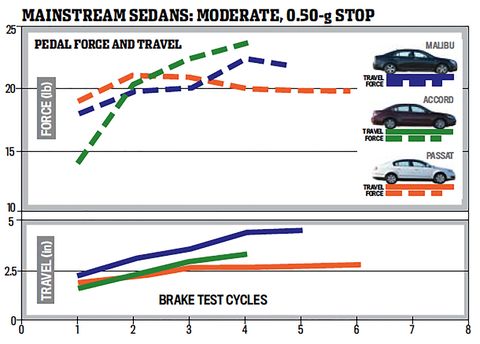
This graph illustrates how far and how hard we had to press the brake pedal to slow the cars from 100 mph to rest at 0.50 g. As we performed our test cycles, the brakes got progressively hotter, and we had to press the pedal farther and harder to achieve the same deceleration.
Car and Driver
The Accord performed its first panic stop in 370 feet. The brakes hung in for a while, but the ninth panic stop had stretched to 460 feet. The pedal travel also grew dramatically over the course of the test, increasing until the pedal nearly kissed the fire wall on the 12th panic stop.
The Malibu’s pedal travel also grew as the test went on, but the braking distances remained more consistent than the Accord’s. The 10th panic stop was within nine feet of the first (374 versus 365). The next five stretched to between 405 and 469 feet, and then, inexplicably, the brakes recovered, and the last stop required only 387 feet.
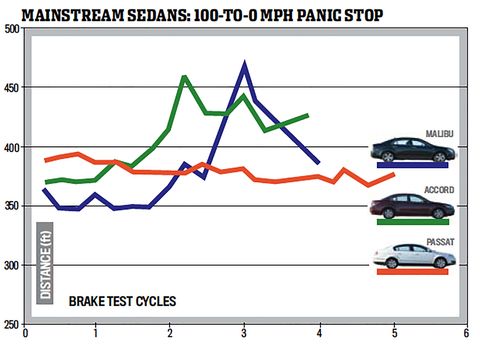
The 100-to-0-mph braking runs were done by engaging the anti-lock braking system. The Passat remained impressively consistent over 20 hard stops.
Car and Driver
One interesting observation: The fade was made evident more by increased pedal travel than by rising pedal force. The Passat was the least affected, followed by the Malibu and Accord, in which pedal force almost doubled. Still, these everyday cars illustrate how robust modern braking systems are. All three sedans survived a duty cycle even more brutal than we would administer in the real world, and there was plenty of warning before things went awry.

Car and Driver
Luxury SUVs
The amount of heat that brakes must dissipate is directly related to a vehicle’s weight, thus the brakes fitted to these heavyweight steeds face a tough mission. The FX50S was the lightest at 4643 pounds, the SRX came next at 4762 pounds, and the Cayenne S was the heavyweight, posting a brake-killing 5476 pounds.

The Cayenne’s pedal force and travel barely changed while the SRX’s performance gradually fell off. The FX50S’s brakes, however, went away in fewer than 10 stops, with huge spikes in distance, pedal travel, and pedal force.
Car and Driver
The Porsche’s brakes, however, shrugged off the 2.75 tons with little effect. After 25 stops, we simply gave up because the pedal feel changed little (it grew just an inch), and the last stop, at 356 feet, was only 20 feet longer than the first. Clearly, the 90 seconds of cool-off time between runs was enough to keep the Cayenne’s brakes from overheating.
The SRX acquitted itself fairly well, considering it’s not as performance oriented as the two other SUVs. Although the distances for the first nine panic stops were reasonable, ranging between 367 and 430 feet, things went downhill from there. After the 15th panic stop, the distance increased to 485 feet and the pedal lost its firmness, so we parked the vehicle.
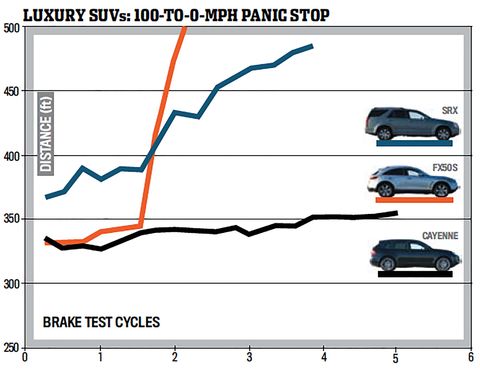
Car and Driver
The FX50S fared even worse. Not only did its brakes give up much sooner than those of the two other SUVs, they did so with little warning. Things were fine after the first six panic stops, with distances hovering around 340 feet. On the seventh stop (in the second test cycle), the pedal travel grew markedly longer and the distance increased to 432 feet. On the eighth, the pedal went to the metal. We held it there, and the Infiniti gradually came to a stop in 473 feet. We tried a few more times, but the car was braking with only half its maximum capability even though we were pushing on the pedal with more than 100 pounds of force. Afterward, we discovered that the rotors were deeply grooved, too. We contacted Infiniti, and the company says it is investigating the problem.

Car and Driver
Performance Cars
Not surprisingly, the Corvette and the two Porsche 911s performed very well in this test. We grew weary trying to the get their brakes to fade. All three cars survived more than 35 back-to-back stops from 100 mph without a decrease in performance. That feat is even more amazing when one considers the relatively brief 20-second interval between stops.
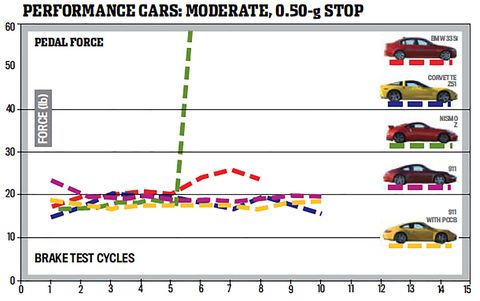
Car and Driver
The 911 with the PCCB system performed about the same as the other 911 and the Vette. The average stopping distances of the two 911s were within a foot of each other (305 feet), not surprising since both cars were wearing the same tires. The Corvette averaged 326 feet. The conclusion: PCCB buyers enjoy a 37-pound weight savings but not necessarily more robust brakes.
The NISMO Z comes with a set of big Brembo brakes, but we didn’t find these binders to be up to par with those of the other performance cars. As with the FX50S, we saw a big change in the NISMO Z’s brake performance. The 15th panic stop was more or less the same as the first, with consistent stopping distances in the 320-foot range and less than an inch of increased pedal travel. But on stop 16, the pedal bottomed out, the distance increased 38 percent (to 448 feet), and it just got worse thereafter. This sudden increase in pedal travel suggests that the brake fluid was simply getting too hot, so we suspect that a change to higher-temp fluid would greatly improve braking performance.
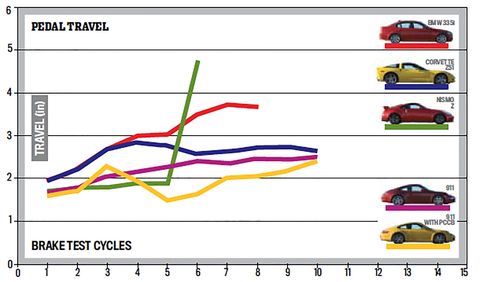
Car and Driver
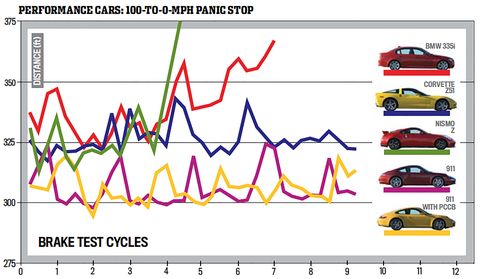
Today’s top-flight sports cars have fantastically strong brakes, as illustrated by the consistent performance of the Vette and the 911s. The BMW was quite good for a sports sedan. The NISMO Z was fine for a while, then like the Infiniti FX50S, fell off dramatically.
Car and Driver
The BMW 335i isn’t as overtly sporting as the others, but it has a unique system called brake-fade compensation that automatically increases hydraulic pressure as the brakes get hot. The BMW’s brakes did very well; we performed seven complete test cycles until a brake-warning light flashed, encouraging us to quit. Over that time, the pedal travel increased by 1.8 inches, and the force required to do those 0.50-g stops increased by about 30 percent. Unfortunately, we couldn’t quantify the benefit of the brake-fade compensation because we couldn’t turn off the system.

Car and Driver
About That Dust
The contact between the brake pads and rotors is analogous to rubbing sandpaper against wood: As a result, there’s dust. The dusty, black residue gathers on wheels, much to the annoyance of fastidious car owners. Brake dust has become a hot topic among carmakers since J.D. Power and Associates, the company that surveys car owners and publishes the influential Initial Quality Study (IQS), began asking whether cars produce excessive brake dust. A “yes” answer adds to the tally of problems audited in the IQS rating.
The amount of dust produced—and the likelihood that it will end up dirtying the wheels—depends on many variables, including the chemical composition of the brake pads, the particular alloy of the rotors, the airflow around the brakes, and even the wheel design itself.
The attributes that make a braking system resistant to fade are also typically the same characteristics that produce more dust on the wheels. For example, solid disklike wheels would keep dust from accumulating on the outside of the wheel, but those wheels would restrict airflow. Pads that retain their frictional characteristics when temperatures rise to more than 1000 degrees produce more dust during normal driving than pads that fade severely when hot.
Some companies—Porsche for one—feel the IQS survey unfairly penalizes manufacturers of high-performance brakes. Donatus Neudeck, Porsche’s development manager for brake systems, says: “Our cars can go from the street to the racetrack without hesitation. We could change the pad material to help the dust problem, but we would never do that. We may have more dust on the wheel, but we provide our customers with better braking performance.”
Until someone invents a magic pad that survives high temperatures but produces less dust, enthusiasts may have to rely on a simple solution: a garden hose and a brush—once the brakes have cooled down, of course.



